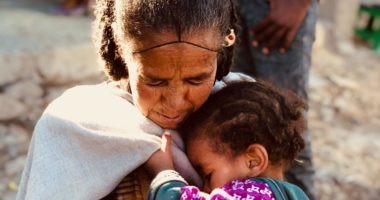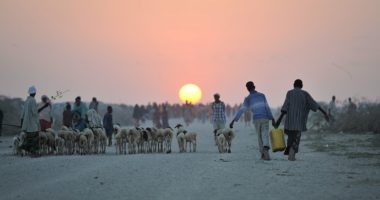Although internal displacement is a global problem, it has long been a particular concern for African governments. According to the most recent estimates, conflict and violence have uprooted 21.8 million people from their homes in sub-Saharan Africa, a rising trend driven each year by other factors such as natural hazard-induced disasters, climate risks, and a dearth of durable solutions.
In this post, Judith Oputu, Diplomatic Adviser for Africa working with the ICRC’s Policy and Humanitarian Diplomacy Division, reflects on displacement diplomacy in Africa and outlines five ways that African States can be better incentivized to take action.
2019 could be considered the last golden year of robust international and regional political engagement on internal displacement. It was the year the UN Secretary-General established the High-Level Panel on Internal Displacement to prompt action to prevent displacement, respond to and provide solutions for the world’s internally displaced people (IDPs). It was also the year designated as the year of refugees, IDPs and returnees by the African Union (AU), a decade after the adoption of the AU Convention for the Protection and Assistance of Internally Displaced Persons in Africa, also known as the Kampala Convention, and four years after the adoption of the AU Convention Governing the Specific Aspects of Refugee Problems in Africa. In both instances, Africa has shown clear leadership in developing adapted policy instruments to better govern forced displacement on the continent.
Since 2019, despite alarming numbers, the global, regional and national policy spotlight on internal displacement in many places has been dimming as other competing emergencies are being prioritized, notably the COVID-19 pandemic, its socio-economic ramifications, and counterterrorism. The release of the report of the High-Level Panel was a high point in 2021, but it has not yet garnered the attention and momentum expected.
More needs to be done to stimulate adequate action, notably through displacement diplomacy i.e. diplomatic engagement by States, humanitarian organizations and other actors that focuses on the forced mobility of persons. Here are five points for consideration.
1. Prioritize bilateral dialogue
There has been significant policy progress with the adoption of the Kampala Convention – the only legally binding treaty on the protection and assistance of IDPs in the world – and consistent engagements on the topic by regional and sub- regional organizations like the AU and various Regional Economic Communities. 31 African countries out of 54 have ratified the Kampala Convention and one (Niger) has domesticated it. Some ten countries have some form of IDP specific national policy and Kenya has an IDP law. Multilateral level engagements which mobilized action and created the space for addressing this often-sensitive issue can be credited for the majority of these advancements.
However, now, while African leaders recognize and consider internal displacement both as a political and humanitarian challenge, the translation of international and regional commitments into lasting solutions at the local and national level remains a problem. This is where greater emphasis is needed and where stronger bilateral diplomacy needs to come in. Statements of intent need to go beyond meetings and events. While convening summits, conferences and other high-level engagements at the regional and international levels can help create momentum for action, there are limits to what they can deliver. Bilateral dialogue can draw attention to specific needs and protection concerns, provide contextualized concrete recommendations on how responses could be improved, and provide support through legal and technical guidance.
Displacement diplomacy at the international and regional level is critical, but the national level is where the fulcrum of power for change currently lies. Nothing will change unless work is done in-country with the relevant stakeholders. Regional and international actors need to go beyond multilateral engagement and make displacement a priority on the agenda of their bilateral political, economic and social dialogues with national level stakeholders. Bilateral relationships with governments of impacted countries need to be better leveraged to press for the protection of IDPs and the resolution of their displacement.
2. Address disincentives to political will
Dialogue at the national level on internal displacement tends to be sensitive and politically contentious. Many States feel more comfortable speaking about refugee situations, in particular regarding refugees they might be hosting, but will draw the line when it comes to the realities of internal displacement, especially in the context of armed conflict or other situations of violence. Some States resent any perceived infringement on their sovereign right to respond to domestic political and security situations. Others are reluctant to admit to internal displacement, conflating this with an admission of armed conflict or violence that could harm the image of the government. Internal displacement issues are often swept under the rug, with IDPs treated in the same manner as other habitual residents without consideration of their specific needs. Some governments do not regard IDPs as citizens in need of protection and might even consider them to be foreigners, migrants or ‘the enemy’, their hardships illegitimate. The variances between afflicted populations and their governments contributes to the growing figures and insufficient progress made.
While a country’s failure to pass legislation or adopt specific IDP policy measures could be interpreted as a lack of political will, this interpretation needs to be nuanced, as such failures might also be attributed to a lack of capacity, political or institutional conflicts. For effective diplomacy, it is key to distinguish between will and capacity, although both are closely connected. Many countries facing conflict and displacement suffer from severe resource shortages, making them reluctant to commit even where there is a will. As a result, what may appear to be a lack of political will might instead be a lack of capacity. The political calculus would therefore be to shy away from prioritizing a problem when there are no means or resources with which to address it. The incentive to adopt appropriate policies and laws to frame action can be considered meaningless where means are lacking.
The main challenge for diplomacy will be to actively address these disincentives to political will and alter the incentive calculus so that there is a reason to accept responsibility for displacement, or at the very least to mitigate its effects.
3. Work at a local level
Displacement diplomacy typically focuses on the highest levels of a country’s political structure, concentrating on a few powerful individuals. While this is a valid strategy, it is crucial to remember that political will does not only come from the top; it can be fostered from below. Local groups are very important and need to be better incorporated in diplomacy, especially as governments are increasingly sensitive to perceived external interference. These could include public officials on the front lines of service, local and municipal authorities, Red Cross and Red Crescent National Societies, civil society organizations, the corporate sector and affected populations themselves, whose painful, real-life stories can be persuasive.
As the recourse to the principle of State sovereignty limits the ability of the international community to intervene, local voices in some contexts can be better placed to raise concerns on internal displacement for the economy, security, stability and social well-being of the entire country. Unaddressed and extended displacement has disastrous effects, not only for the displaced, but also for the host communities and the communities they leave behind. Large-scale displacement depopulates communities and can negatively impact farming, land and housing care; forests and grasslands are quickly stripped for homes and fuel where people flee to rural areas. When individuals flee to cities, the population of those cities might double or triple. Overcrowding occurs swiftly, putting a strain on social services, water supplies, and sanitary facilities.
In 2012, when Kenya passed its IDP Law, the impetus for reform came from civil society, which kept the focus on the national agenda and political realities. The push for change should not be overtly centered on external forces; real change also needs to be ignited from within. Often when solutions become externally determined or dominated the strength of initiative begins to slip away from local stakeholders, with negative impacts on political will and ownership. International and regional actors and fora need to continue to play their key role in fostering the political will from outside but to move beyond the current impasse where governments often ignore their international commitments. Another fulcrum of emphasis could be national actors and discussions at the national level, where significant institutional changes are required, and bottlenecks lie.
4. Connect to the development and peace agenda
Internal displacement is both a humanitarian and development problem, yet advocacy for action on internal displacement could benefit from a stronger focus on the developmental implications. This aspect is not always the front and center of displacement diplomacy, which tends to focus on humanitarian impacts. To make the links, incentivize action and better connect with African authorities, it is key to better connect to their priority concerns such as development and regional transformation, conflict resolution and climate change.
Internal displacement’s long-term consequences, especially in situations of large-scale and protracted displacement, can have a collective impact on development at local and national levels. For starters, displacement destabilizes growth in areas of origin by causing a flight of money and human resources. Second, the entrance of IDPs in a host community creates economic and societal constraints and opportunities that have an impact on those communities’ development processes. Third, the abrupt, unanticipated, and difficult-to-quantify changes in population distribution caused by internal displacement present a challenge for development plans based on pre-displacement population and demographic assumptions. Finally, internal displacement may trigger or accelerate other social change processes such as urbanization, shifts in gender roles, etc. that can affect a country’s long-term growth. It is in the self-interest of national governments vis a vis their development goals to address internal displacement as sustainably as possible, as highlighted by Vera Songwe, UNECA Executive Director to the 34th Ordinary Session of the Executive Council of the African Union in 2019 on internal displacement: ‘An Africa in search of growth cannot afford the luxury of camps of unproductivity’. Thus, the development perspective is a plausible entry point for diplomacy.
Furthermore, referencing the Swiss Federal Department of Foreign Affairs and Humanitarian Policy Group submission to the High Level Panel, peace processes that incorporate displaced groups and take their interests and needs into consideration are more likely to be successful. As a result, maintaining peace and finding long-term solutions to displacement are interconnected objectives and could be a persuasive perspective that could be better incorporated into exchanges with national actors.
5. Leverage data
Data on internal displacement remains a long-term problem. The ability to make sound policy decisions can be hampered by a lack of data. Governments require timely, accurate and disaggregated data on internal displacement to make informed policy choices. Even though the culture of data use in many African countries needs to be strengthened, such data when available can be very persuasive.
Beyond sharing data, while respecting principles of data protection, the inclusion of national authorities in data gathering and analysis can foster ownership of the data and ultimately political will and accountability. Better connecting national actors to data production where feasible could encourage governments to step up their positions as principal duty bearers in responding to internal displacement. It might also help assuage the reservations African governments might have towards data generated by humanitarian and other international actors. Misgivings about data, for example related to numbers of displaced persons and geographic dispersion, have led to data rejection and ultimately inaction.
Conclusion
Any way you approach it, the current internal displacement conundrum will require out-of-the box thinking. To better galvanize policy and practice in favor of IDPs, displacement diplomacy will need to embrace innovative approaches and set its sights on concretely addressing the increasing disincentives to political will.
See also
- Catherine-Lune Grayson, Internal displacement: Some reflections on cracking the urban challenge, September 23, 2018
- Sir Michael Aaronson, Refugees, migrants, IDPs: Protecting people on the move—without distinction, October 9, 2017
- ICRC, The Kampala Convention: Key Recommendations Ten Years On, 2020
- ICRC, Stocktaking exercise: Translating Kampala Convention into practice?, 2018






Comments